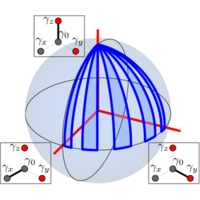Abstract
A universal quantum computer requires a full set of basic quantum gates. With Majorana bound states one can form all necessary quantum gates in a topologically protected way, bar one. In this paper, we present a scheme that achieves the missing, so-called, magic phase gate without the need of fine-tuning for distinct physical realizations. The scheme is based on the manipulation of geometric phases described by a universal protocol and converges exponentially with the number of steps in the geometric path. Furthermore, our magic gate proposal relies on the most basic hardware previously suggested for topologically protected gates, and can be extended to an any-phase gate, where is substituted by any .
1 More- Received 16 December 2015
DOI:https://doi.org/10.1103/PhysRevX.6.031019
This article is available under the terms of the Creative Commons Attribution 3.0 License. Further distribution of this work must maintain attribution to the author(s) and the published article’s title, journal citation, and DOI.
Published by the American Physical Society
Physics Subject Headings (PhySH)
Popular Summary
The vision behind topological quantum computation involves employing simple braiding operations of non-Abelian quasiparticles in two-dimensional systems in order to carry out quantum gates. The resulting quantum information will then be protected since it will be encoded in the topological properties of the quantum state in a way that is spread out over an entire system and inaccessible to any local disturbance or measurement. Majorana bound states are by far the simplest, non-Abelian quasiparticles known, and they have already been realized experimentally. Unfortunately, the braiding operations of Majorana states are not enough to build a full-fledged quantum computer. The remaining ingredient that would unlock full quantum universality is a so-called magic gate (or gate) that corresponds to an exact superposition of doing and not doing an exchange between two Majoranas. Not being able to carry out this gate in a protected way is a major hindrance to topological quantum computing. Here, we offer a resolution for this problem and explain how to perform a magic gate without any fine-tuning.
We consider a setup of four Majoranas and show that such a magic gate results from combining noise-canceling methods of quantum control with the underlying topological protection of Majorana states. Our scheme requires no special hardware beyond what is expected for all other necessary gates. By sweeping back and forth in the (geometric) parameter space that defines the gate operation, errors due to experimental imperfections drop exponentially in the number of sweeps. This “geometric decoupling” significantly enhances the quantum-control toolbox of Majoranas, providing novel pathways for exponentially and universally protected gates.
We expect that our findings will pave the way for magic-gate schemes that can be realized for many types of environmental noise.



